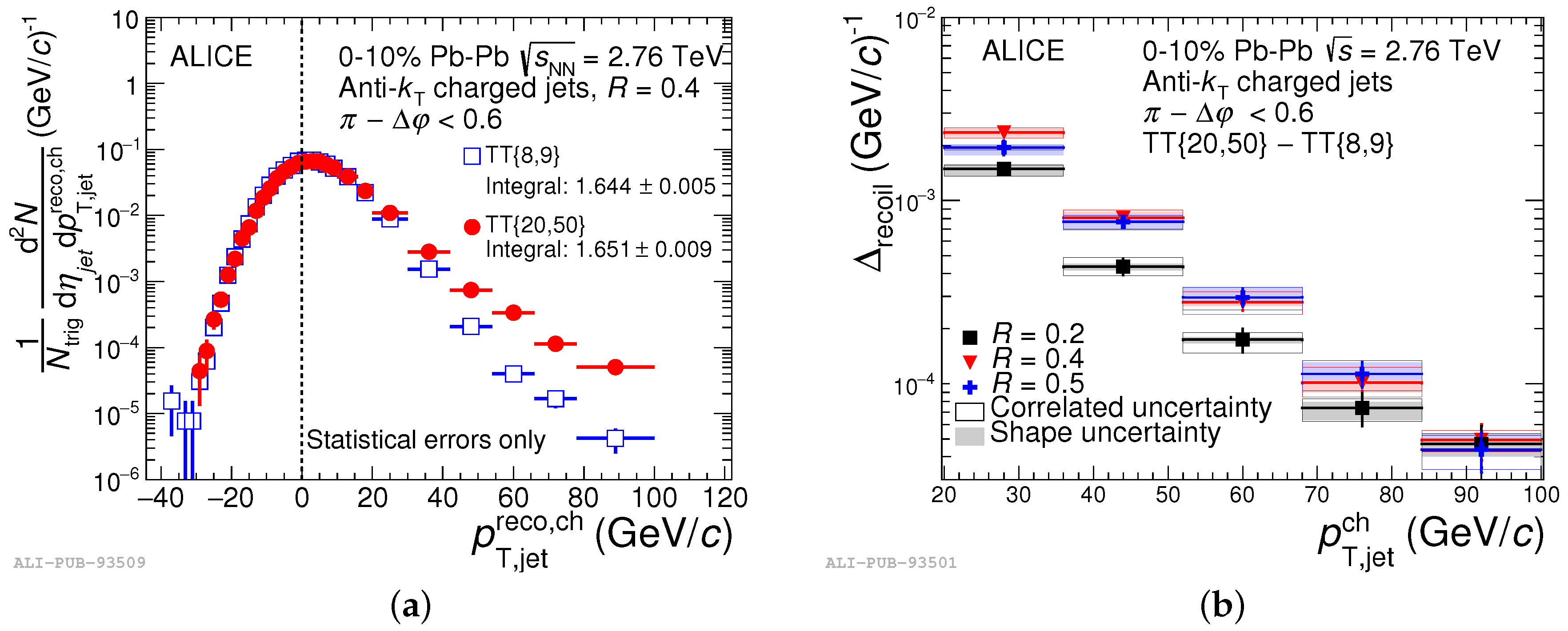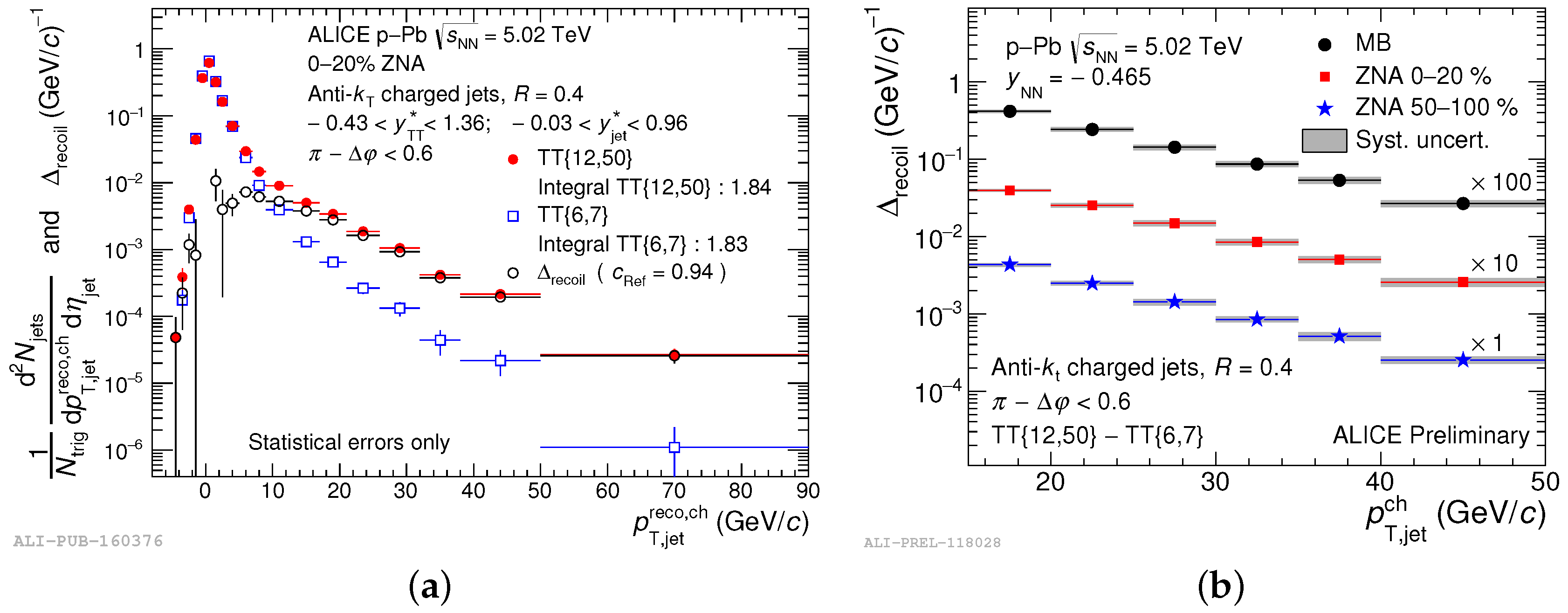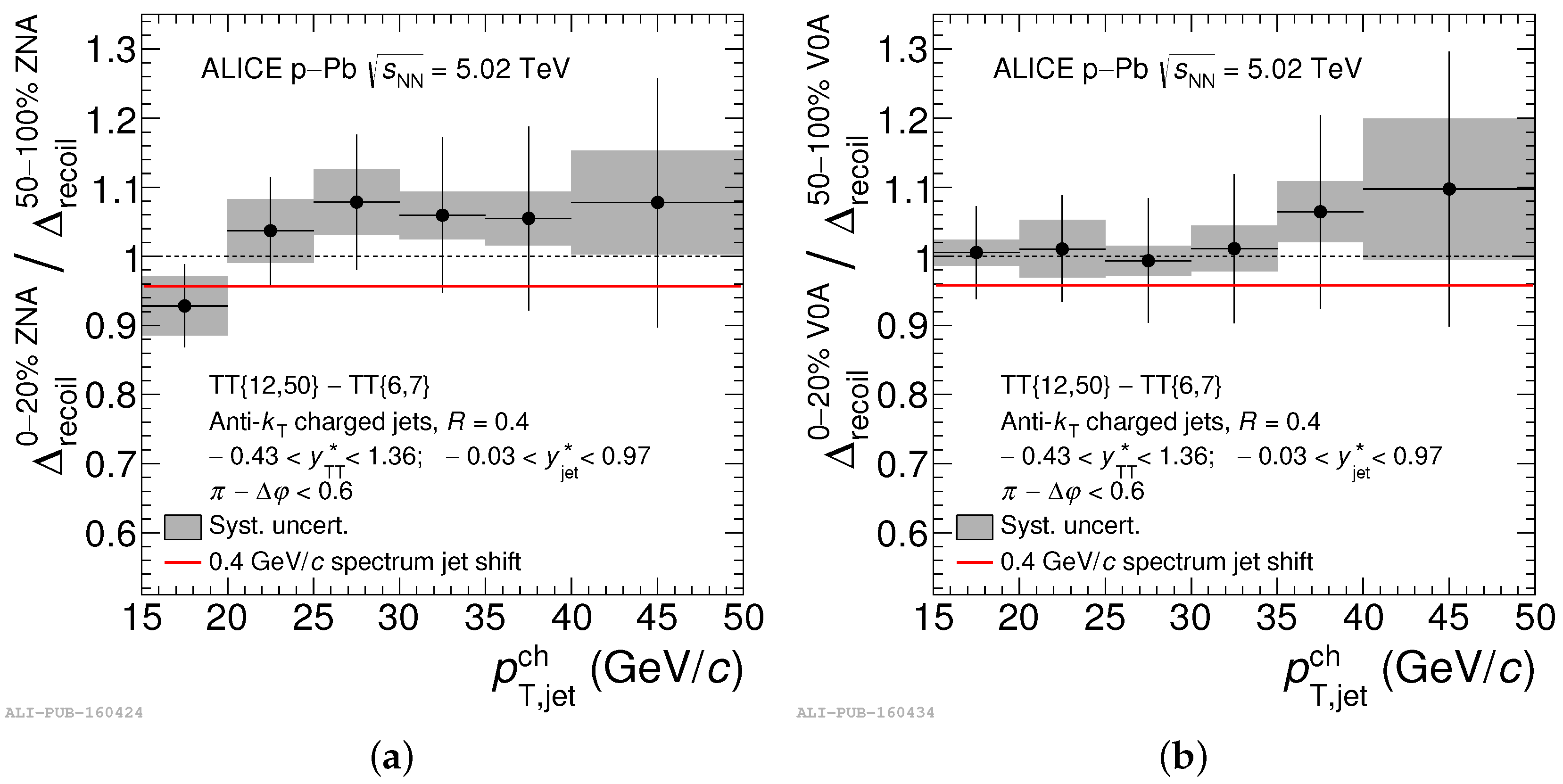1. Introduction
Ultra-relativistic heavy-ion collisions are used to probe the properties of strongly interacting matter in the regime of extremely high-energy densities and temperatures and vanishing baryochemical potential [
1]. Lattice quantum chromodynamics calculations predict that under such conditions, the hadron gas phase undergoes a transition to the state called quark–gluon plasma (QGP) [
2]. In this phase, quarks and gluons are released from their confinement in hadrons. The transition has a smooth cross-over character and happens at a temperature of about 150 MeV [
3].
A collision of heavy ions creates a rapidly evolving dynamical system where the QGP phase lasts only a short instant. As the collision zone expands and cools, quarks and gluons merge together, giving a rise to a multitude of hadrons that further interact among each other until the kinematic freeze-out is reached [
1]. When particles from the collision reach our detector, the QGP does not exist anymore; therefore, properties of the QGP can be investigated indirectly only. Among different experimental observables that are studied in this context, two of them are believed to be directly associated with the production of the QGP in heavy-ion collisions: the large azimuthal-momentum space-anisotropy of produced particles [
4,
5] and the jet quenching phenomenon [
6,
7]. The first observable is connected with the time evolution of the initial spatial anisotropy of the collision zone, which results in an azimuthal-momentum space-anisotropy of produced particles. Hydrodynamic calculations, which model this process, show that the magnitude of the observed flow is compatible with QGP behaving like a nearly perfect liquid with a very small shear-viscosity to entropy-density ratio [
8].
The jet quenching phenomenon is manifested by a marked reduction of energy of high- hadrons and jets that traversed the QGP medium. Their yield measured in heavy-ion collisions is suppressed when compared to the yield that would be expected from a superposition of the corresponding number of independent pp collisions.
Jets are intuitively understood as collimated sprays of particles that are produced by the fragmentation of highly virtual partons. The exact definition of a jet is done with jet reconstruction algorithms [
9]. These algorithms were designed to recover energy of the original parton by summing up momenta of final-state particles. In elementary collisions, the production of jets is well-described with the perturbative quantum chromodynamics [
10]. In heavy-ion collisions, highly virtual partons that fragment to jets are produced by hard scatterings that happen before the QGP is formed. The parton shower thus gets modified while these partons traverse the medium [
11]. Based on the observed modification, medium properties can be inferred. Jets are thus considered well-suited probes of the produced QGP.
Jets in heavy-ion collisions are accompanied by an intensive underlying event. A jet reconstruction algorithm therefore often clusters together just soft particles from the underlying event and creates a so-called combinatorial background jet. One way to suppress the contribution of these artificial jets is to require the presence of a high-
constituent within the reconstructed jet [
12]. This condition, however, imposes a fragmentation bias on the reconstructed jets and can essentially affect the selected jet sample. As we will see in the following section, hadron-jet coincidence measurements offer a way to overcome this problem [
13]. They allow the removal of the contribution of combinatorial background jets, including the contribution from multi-parton interactions, without imposing the fragmentation bias on analyzed jets. The method is data-driven and uses statistical subtraction. It is suitable also for jets having large
R and low
.
2. Hadron-Jet Coincidence Measurements in Pb–Pb Collisions at TeV
A principle of hadron-jet coincidence measurements will be explained based on the analysis of Pb–Pb collisions at
TeV recorded by ALICE in 2011. The same analysis procedure will be then applied to the data from p–Pb collisions at
TeV from 2013. Further details about both data sets and analyses can be found in the original papers [
14,
15].
ALICE is one of the four big experiments working at the Large Hadron Collider at CERN. The ALICE apparatus is described in detail elsewhere [
16]. Let us note that track reconstruction is based on position measurements performed by a six-layer silicon tracker called the Inner Tracking System [
17], which surrounds the interaction point, and the Time Projection Chamber [
18]. Both detectors have full azimuthal coverage, and tracks can be efficiently reconstructed in the pseudorapidity range
. Both detectors are placed in a 0.5 T solenoidal magnetic field, which ensures reasonable transverse momentum resolution for tracks in the range
GeV/
c.
Track-based jets are reconstructed from charged tracks with
GeV/
c using the infrared and collinear safe anti-
algorithm [
19] as implemented in the FastJet package [
20]. Reconstructed jets have a resolution parameter of
and are assembled using the boost-invariant
-recombination scheme. Pseudorapidity of jets is constrained by a fiducial cut
to remove jets whose jet cone overlaps with boarders of the ALICE acceptance. The reconstructed transverse momentum of jets,
, is corrected for the mean underlying event contribution on an event-by-event basis by subtracting a product of the mean underlying event density
and jet area
,
Here, the mean underlying event density is estimated by the standard area- based approach [
21] as
which is calculated based on a sample of reconstructed
track-based jets with
.
In hadron-jet coincidence measurements, we analyze events that contain a high-
track, the so-called trigger track or TT. The presence of a high-
particle unambiguously selects events with a hard scattering. The trigger track
is required to be in some chosen range
GeV/
c, which is denoted TT{
X,
Y} throughout the text. If multiple TT candidates are found, one of them is chosen at random. Jets, which are to be analyzed, are selected to be nearly back-to-back in azimuth w.r.t. to TT,
where
and
denote azimuthal angles of TT and recoiling jets.
Figure 1 shows the per trigger normalized transverse momentum spectra of recoil jets associated with two exclusive trigger track
bins TT{8,9} and TT{20,50} in the 0–10% centrality bin of Pb–Pb collisions at
TeV. Note that both spectra exhibit a remarkable similarity in the region
, where their shape does not depend on the transverse momentum of TT. Jets populating this region are predominantly combinatorial background jets, which are accidentally associated with TT. On the other hand, in the region
, both spectra differ. Since the presence of a TT{20,50} hadron biases the four-momentum transfer in the associated hard scattering to higher values, the corresponding recoil jet spectrum is harder. The spectrum in the region
also has, however, the component coming from combinatorial background jets. Based on the situation in the region
, it is assumed that this component is independent of TT
. Thus, it will be canceled when both spectra are subtracted.
Here
denotes the number of TT in a given TT bin. Let us point out that on the theory side, the per trigger normalized yield of recoil jets can be expressed in terms of a cross section to produce a high-
hadron and a cross section to produce a high-
hadron together with a jet.
The measured
spectrum was further corrected for jet reconstruction inefficiency and jet energy scale smearing due to instrumental effects and local underlying event fluctuations. The relation between the measured jet spectrum and the true jet spectrum was assumed to be linear, and the combined effect of the instrumental effects and local background fluctuations on the true jet spectrum was described by means of a response matrix. Regularized inversion of this matrix and the corresponding solution for the true spectrum was found by means of Bayesian unfolding [
22,
23]. The fully corrected
spectrum for anti-
jets with
, 0.4, and 0.5 is shown in the right-hand side panel of
Figure 1.
The medium-induced modification of the recoil jet spectrum was quantified by means of a ratio
where
denotes the fully corrected
spectrum measured in Pb–Pb collisions and
is a reference
spectrum obtained from the PYTHIA 6 Perugia 2010 [
24] simulation of pp collisions at the same center-of-mass energy per nucleon–nucleon collision; see
Figure 2. Statistics of the measured pp
TeV data by ALICE was found to be insufficient for this analysis. Nevertheless, for pp collisions at
TeV, the PYTHIA
spectrum reproduces the measured data very well [
14]. The
ratio is found to be below unity, which shows that the studied sample of recoil jets was affected by jet quenching. Similar suppression was also found for track-based anti-
jets having
and
[
14].
3. Searches for Jet Quenching in p–Pb Collisions at TeV
In past, the PHENIX collaboration has searched for jet quenching in d–Au collisions at
GeV [
25]. PHENIX measured a nuclear modification factor of inclusive anti-
jets with
. The nuclear modification factor was calculated as
where
is the nuclear overlap function for a given centrality bin of deuteron–gold,
is the inclusive cross section for jets in pp collisions at the same nucleon–nucleon center-of-mass energy and
is the measured spectrum of jets for a given centrality in d–Au. PHENIX found that
is compatible with unity for minimum bias events. However, once they sorted measured events in centrality classes, they found significant enhancement for peripheral events and suppression for central events. The behavior of
for peripheral events was surprising since peripheral events were expected to be similar to pp. The similar ordering of the nuclear suppression factor for jets was seen also by ATLAS in peripheral and central p–Pb collisions at
TeV [
26]. The interpretation of these results in terms of medium-induced modification of jet production is problematic, since the calculation of the nuclear overlap function does not take into account conservation laws, which play an important role in small systems [
27], e.g., momentum conservation. The detection of a high-
jet at midrapidity affects measurement of event activity or “centrality” in forward rapidity, and the assigned event geometry can be biased.
Hadron-jet coincidence observables have the advantage that they can be used to identify jet quenching without the need to know the corresponding nuclear overlap function [
15]. If there were no medium-induced modifications of jet production in p–Pb, cross sections appearing on the right-hand side of (
5) could be expressed in terms of the corresponding pp cross sections and the the nuclear overlap functions
,
Since the nuclear overlap function term appears in the numerator and denominator, they cancel. It is thus not necessary to know the relation between the measured event activity and the collision geometry.
Analysis of
spectra in p–Pb collisions at
TeV is analogous to what was done in Pb–Pb. In p–Pb, event activity was measured by two forward detectors, the neutron zero degree calorimeter (ZNA) and the V0A scintillator array.
Figure 3 shows the per trigger normalized yield of recoil jets associated with the chosen trigger track
bins TT{6,7} and TT{12,50} in 20% of p–Pb events with the largest event activity in the ZNA. The resulting raw
distribution is shown by open circles.
The right-hand side panel of
Figure 3 shows the fully corrected
spectra obtained for minimum bias p–Pb events, for 20% of events that had the largest event activity in the ZNA, and for 50% of events that had the lowest event activity in the ZNA. Medium-induced modification of the spectrum was studied by means of the ratio of the
spectra measured for the high and low event activity; see
Figure 4. The data are compatible with unity and do not exhibit a visible jet-quenching effect. Furthermore, we used these data to provide a limit on the magnitude of medium-induced energy transport to large angles out of the
jet cone. The fully corrected
spectra have an exponential shape (
Figure 3). Under the assumption that higher energy density in events with higher event activity would cause a horizontal shift of the
spectrum, we can parameterize the
spectra measured for low- and high-event activity as
and
, respectively. Here,
a and
b are constants, and
is the spectrum shift. The corresponding ratio is then
. The ratio is independent of jet
and can be used to extract
provided that the ratio and the slope parameter
b are extracted from data. Thus from the data in
Figure 3 and
Figure 4, the following estimates for the spectrum shift were obtained [
15]:
GeV/
c for events where event activity was measured by ZNA, and
GeV/
c for events where event activity was measured by V0A. Both values are consistent with zero within uncertainties.
The measured
values were further used to set a one-sided 90% confidence upper limit on the medium-induced charged energy transport out of the jet cone of
for jets with
GeV/
c. In events with high V0A or high ZNA activity, the medium-induced charged energy transport is less than 0.4 GeV/
c at 90% confidence. This limit is shown by the red line in
Figure 4.
In summary, observables that are based on correlations of high- hadrons with jets provide a powerful tool to probe properties of the medium created in heavy-ion collisions. This approach makes it possible to cope with a large underlying event and does not induce fragmentation bias on the studied jet sample. Is is also well-suited for jet quenching studies in small systems since their interpretation does not depend on models that relate collision geometry with event activity.








